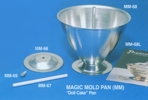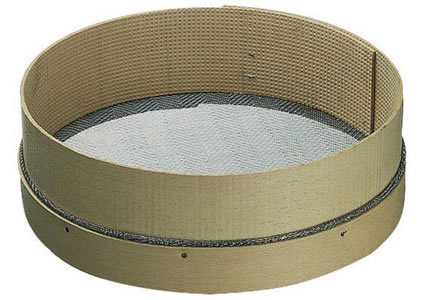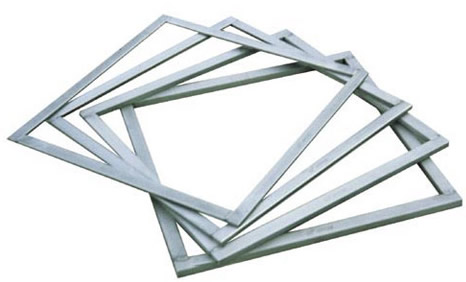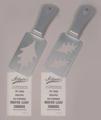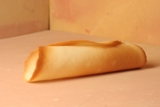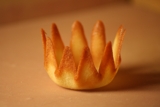The
name 'tuile' is a french word meaning 'tile,' and when presented in
rows are supposed to resemble the curved tiles on the tops of buildings.
In their traditional form, a tuile (petit
four style cookie) is a flat cookie which has been
set over a curved surface while freshly baked and allowed to cool, giving
its characteristic curved-tile shape. To achieve its curved shape, you
can set over a dowel (both ends balanced so as to not roll). Different
diameters of dowels can be used depending on the size of the finished
cookie. When I was in the kitchen, I used the end of a small table next
to the ovens conveniently containing a 'crumb' lip, which was curved
at the front of the table. It was made of the same material as the table,
stainless steel, had no seams and made the perfect curves. It was similar
to a long cylinder from a tuile mold sheet. A tuile
mold sheet (see picture below) is an undulating sheet
containing several cylinders to allow these thin cookies to cool in
the traditional curved shape, and is made special for tuile cookies.
Other things that can be used for curving: rolling pins, inside of long
pastry molds, or the lips of many high sided baking molds. It doesn't
matter how they are curved; just be sure they are left long enough to
fully crisp and harden or they will open up as they cool.
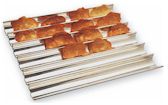 
It's
important to note that if nuts or other garnishes are to be used in
the tuile cookie, placement onto the curved surface is important. Depending
on the surface (concave like a surface similar to a tuile mold sheet
(curved down), or convex like a surface similar to a dowel, (curved
up)), lay them down right-side up or upside-down so that the 'garnished'
side is the side that is up, the top of the arch. Otherwise the flat
side will be the one displayed. They are generally presented in rows
if used in a buffet or for display, or stacked up two or three together
as individual petit fours or mignardise.
If, when baking, the circles you made turn elongated or more of an oval
shape, put the longer ends as the front and back of the cookies and
the thinner as the sides. They will stack up evenly with the rest of
the cookies in rows.
These cookies are
fragile and crisp, and should be made the same day they are to be served,
especially in humid climates. Storage
of them should be airtight, and if not used the same day, should be
used within a couple of days, as the main feature of a tuile is that
it's dry and crisp. Care should be taken as to how they are arranged
either in a storage container or a covered plate since they are so fragile.
A common batter is mixing egg whites with powdered sugar and melted
butter with the addition of flours like all purpose or ground nuts.
Some others contain only cream in place of the whites. Some recipes
have a garnish to them, like chopped nuts, grated zests or chopped citron.
While tuile cookies are generally made with the above ingredients, and
using just about any flavor like chocolate (cocoa), citrus zests, or
chopped or sliced nuts to flavor and complement, some cooks classify
lace cookies in the tuile category since they are flat, fragile, and
can be molded when hot into the traditional curved shape. Read each
tuile recipe procedure before beginning, as some require a template
to smooth the batter into shape, and some use a pastry bag to pipe or
a spoon to spread and the result is a round shape to be formed into
a curve.
While
the traditional shape is popular as petit fours, you can find tuiles
not only flat, but in any shape you can imagine for all applications
for pastry plate and buffet design. Using a tuile template any shape
can be found and used, or make a cut-out of your own design onto thin
plastic (the lids of industrial sized ingredients like trimoline, glucose
or apricot glazes are good for larger designs, yogurt and sour cream
for smaller ones: draw desired shape and cut-out carefully with a utility
knife). Tuile doughs are especially fragile and baking them on a silicone
baking mat (Silpat for example) will help remove them effortlessly when
finished baking. To use any template, place an amount of the batter
onto the design and using an offset spatula, spread the batter onto
the design. Continue with the rest of the templates if in a sheet, or
if single, lift off and the resulting batter on the baking sheet is
the shape.
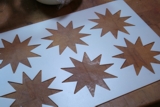 |
|
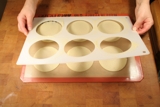 |
Template
Sheet |
Templates
cut from scraps of plastic |
Resulting
batter from template |
| |
|
|
| |
Templates
can be found in aluminum or stainless steel |
|
Tuile
and Related Cookie Info:
- If you see a
recipe with 'dentelle' in the name of a tuile
cookie, it simply means 'lace' in French and the resulting tuile cookie
will probably spread to form a slightly open lace-work pattern, thus
the name.
- Fortune
cookies are a tuile made from a batter and formed while
hot, giving their unique folded shape.
- Cigarette
cookies are thin cookies baked into a round shape (round
templates are helpful with these) and rolled around a thin wooden
stick while they are warm and set up that way.
- Wafer
cookies are thin cookies whose batter can be used in
a template.
- Lace
cookies are simple cookies that spread during baking to a very thin height
with a slight lace-work pattern, and when removed from the oven can
be shaped to any surface. These are very fragile.
- Snaps
or Glass cookies are very thin, almost transparent cookies,
that can also be shaped when pulled from the oven. Take care with
some of the very thin cookies as some may need to set for several
seconds to 'set up' or they can be pulled and distorted out of shape,
and some cookies will harden almost immediately when pulled from the
oven.
- Tulipe
batter (French for 'tulip') or tulip paste is sometimes coined for cigarette or similar batter when
used for making 'tulips' or baskets for plated desserts, which are
molded over or inside of timbales, small bowls or similar molds when
warm.
- Hippenmasse
or Hippen paste is a German thin wafer cookie similar
to a plain tuile or tulip paste, where you pipe out the batter in
designs or spread the batter over a template and bake and form as
required.
With all recipes,
always test a few to see how they can be molded and how much time you'll
have to work with to mold them. Also, if you baked too many on the sheet
pan to mold and some cookies are hard before you get to mold them, simply
place the pan back into the oven for several seconds to warm up, then
form as usual.
Below are several
tuile cookie and other thin cookie recipes, each with different ingredients.
When recipes call for 'melted butter,' for testing purposes we used
only clarified unsalted butter and for 'flour' we used all
purpose flour. All dry ingredients should be sifted to filter out any
lumps in the powdered sugar, flours, cocoa or ground nuts. Egg whites
are large, and should be at room temperature when mixing into the batter.
If making a very large batch and the egg whites are cold, it may set
up the melted butter causing flecks or a very stiff mixture. It's best
to have all ingredients the same temperature. Simply warming slightly
in a bain marie should fix the problem. If the mix will be made ahead,
some batters (like a cigarette batter or plain mix, for example) can
be allowed to come to room temperature before spreading onto templates
for baking. Others using beaten eggs should be used immediately after
mixing. Recipes requiring a pastry bag for piping should be used all
at once, also.
Unless otherwise
noted, recipes came from my recipe box at home or work files or past
'experiments,' or adapted years ago from various recipes. Sources to
all the other recipes are included and listed, as usual, in the bibliography
at the bottom.
Cigarette
Batter (Pâte à Cigarette)
Use this batter for all types of
stencils. This recipe can be easily scaled up or down. Right below this
is the industry version of the recipe. The first is one I scaled down
for my home use. Perfect for making baskets, cigarettes, and multi-colored
designs for plated work. Simply take a small amount and color as desired
and pipe onto the spread cookie before baking. Sets up great, and can
be kept airtight for several days.
2 1/2 oz. powdered
sugar
1 1/2 oz. flour
2 egg whites
1 1/4 oz. clarified unsalted butter
Mix together to
form a smooth batter. Can be made ahead. Allow to come to room temperature
or warm slightly before spreading batter. Using desired templates, spread
onto a sheet pan lined with a silicone baking sheet. Bake at 350°
for about 6 minutes or until browned as desired and mold into shape.
_________________________
Cigarette
Batter (Pâte à Cigarette) Industry Version
Same as the recipe above, but scaled
up for use. Can be made ahead easily and used for many applications
for plated and buffet work.
2 lbs. 6 oz. powdered
sugar
1 lb. 5 oz. flour
1 qt. egg whites (use fresh, not boxed pasteurized)
1 lb. 3 oz. clarified unsalted butter
Mix together to
form a smooth batter. Can be made ahead. Allow to come to room temperature
or warm slightly before spreading batter. Using desired templates, spread
onto a sheet pan lined with a silicone baking sheet. Bake at 350°
for about 6-7 minutes or until browned as desired and mold into shape.
_________________________
Lemon
Cigarettes (Cigarettes au Citron)
Using
very finely chopped candied lemon peel, these have a great lemon flavor.
After baking and cooling, dip the ends in melted white chocolate or
fill as suggested with lemon flavored buttercream using a small pastry
tip. This recipe is adapted from "Larousse Gastronomique,"
publish date 1988.
4 egg whites
Pinch of salt
3 1/2 oz. flour
5 1/2 oz. superfine granulated sugar rubbed with 1/4 vanilla bean, halved
4 oz. clarified unsalted butter
4 oz. very finely chopped candied lemon peel
Preheat oven to
400°F. Whisk egg whites and a pinch of salt to stiff peaks. In separate
bowl, combine the flour, sugar and butter together. Fold in the whites,
then last the finely chopped candied peel. On a silicone baking mat
lined baking sheet, spread mixture into thin circles about 3 inches
in diameter. Bake for about 7-10 minutes or until the tuiles are golden
brown as desired. Remove from oven and while warm, roll each around
a thin wooden dowel or a wooden spoon, remove and set to cool and repeat
with remaining baked tuiles. Repeat with remaining batter until all
of it is used.
_________________________
Milk
Tuiles
I'm not sure where I got this recipe from (it's written down on a recipe
card at home), but these simple tuiles bake up brittle and brown deeply
quickly. They will need to be set up immediately from the oven. I've
also tried this out with canned evaporated milk in place of the cream,
but the flavor is better when the cream is used.
3 oz. powdered sugar
4 oz. flour
1 1/2 oz. cream
3 oz. milk
Mix together to
form a smooth batter. Can be made ahead. Allow to come to room temperature
or warm slightly before spreading batter. Using desired templates, spread
onto a sheet pan lined with a silicone baking sheet. Bake at 375°
for about 6-7 minutes, or until browned as desired and mold into shape.
_________________________
Tulip
Paste
This
recipe uses softened butter rather than melted.
100
g softened unsalted butter
100 g powdered sugar
100 g egg whites
75 g flour
Mix together to
form a smooth batter. Can be made ahead. Allow to come to room temperature
or warm slightly before spreading batter. Using desired templates, spread
onto a sheet pan lined with a silicone baking sheet. Bake at 375°
for about 6-7 minutes, or until browned as desired and mold into shape.
_________________________
Wafer
Batter
Containing equal parts by weight of egg whites, granulated sugar,
melted butter and flour, this is an easy recipe and can be scaled up
easily. Great for any application, and bakes to a good flavor.
2 oz. egg whites
2 oz. granulated sugar
2 oz. clarified unsalted butter
2 oz. flour
Mix together to
form a smooth batter. Can be made ahead. Allow to come to room temperature
or warm slightly before spreading batter. Using desired templates, spread
onto a sheet pan lined with a silicone baking sheet. Bake at 350°
for about 6-7 minutes or until browned as desired and mold into shape.
Allow to cool and serve.
_________________________
Hippenmasse
This recipe contains marzipan,
and is adapted from the site "Chefkoch.de."
180
g sugar
50 g marzipan or fine almond paste
150 g flour
3 large eggs
5 cl cream, or as needed to combine into desired paste
pinch salt
Soften sugar and
marzipan. Add in flour and eggs, mixing in cream together to form a
smooth batter. Using desired templates, spread onto a sheet pan lined
with a silicone baking sheet. Bake at 350° for about 6-7 minutes
or until browned as desired and mold into shape. Allow to cool and serve.
_________________________
Fortune
Cookies
This is an old recipe and uses cornstarch and vegetable oil in the
batter.
1
1/4 oz. cake flour
1 oz. granulated sugar
1/2 oz. cornstarch
1 oz. vegetable oil
1 large egg white
1/2 oz. water
Mix
together to form a smooth batter. Using desired round templates, or
using a spoon spread thinly into a circle onto a sheet pan lined with
a silicone baking sheet. Bake at 350° for about 6-8 minutes or until
browned as desired and mold into shape: first fold in half with the
desired scrap of paper with a saying, then fold in half again over the
lip of a bowl or baking dish. Allow to cool and serve.
_________________________
Hazelnut
Tiles (Tuiles aux Noisettes)
This
recipe is adapted from "The French Cookie Book," and uses
chopped hazelnuts. This batter requires a pastry bag and larger round
tip for piping. Although the recipe calls for hazelnuts, this recipe
was tested with chopped pecans with great success.
3
1/2 oz. finely chopped hazelnuts
3 1/2 oz. superfine granulated sugar
1 large egg, room temp
1 large egg white, room temp
1 1/4 oz. flour
1/2 oz. clarified unsalted butter
Preheat
oven to 400°F. Mix chopped hazelnuts and sugar in bowl and add in
the eggs. Sift flour over the top of the batter and mix in; last the
butter. Transfer the mixture into a pastry bag with a medium or larger
round tip (804-808, depending on your piping skill and the size of the
nuts) and pipe the batter to about 2 1/2 teaspoon sized rounds about
2 inches apart onto a baking sheet lined with a silicone baking mat.
Flatten each tuile batter mound with a fork dipped in water and bake
8-10 minutes until the cookies are browned on the edges. Remove the
tuiles from the sheet pan to shape and cool. Repeat with remaining batter.
It is helpful to have several sheet pans ready at the beginning so as
to pipe all the cookies out at the same time.
_________________________
Tuiles
Adapted from "The New
Cookie Book," this basic tuile can be flavored as desired depending
on the garnish sprinkled on the cookie mounds before baking. Sliced
almonds or chopped hazelnuts or pistachios could be used, for example.
1
large egg white
2 oz. superfine granulated sugar
1 oz. clarified unsalted butter
1 oz. flour, sifted
Garnish, if desired.
Preheat
oven to 375°F. Whisk the egg white to stiff peaks. Add in the sugar
until glossy (will resemble a meringue). Fold in 1/3 of the melted butter
with 1/3 of the flour. Mix until incorporated, then repeat with the
rest of the butter and flour. Spoon small mounds onto parchment or silicone
baking sheet lined baking sheets. Spread out slightly with the back
of fork or fingertips dipped in water. Sprinkle with garnish if using,
then bake 6-7 minutes until golden around the edges. Leave to cool for
a few seconds on the sheet pan before removing to shape. Repeat with
remaining batter until all of it is used.
_________________________
Chocolate
Cigarette Batter
Depending on the color of the cocoa powder being used, the batter
and resulting cookies will either be light brown to rich black. When
the batter is darker, test one out first and mark down the times for
the rest of the baking, as you won't be able to tell when the tuiles
are over cooking when the batter is already dark.
3
oz. clarified unsalted butter
3 oz. powdered sugar
3 oz. egg whites
2 1/2 oz. flour
1 oz. cocoa powder.
Mix
together to form a smooth batter. Can be made ahead. Allow to come to
room temperature or warm slightly before spreading batter. Using desired
templates, spread onto a sheet pan lined with a silicone baking sheet.
Bake at 350° for about 6-7 minutes or until browned and cooked as
desired and mold into shape.
_________________________
References
used:
Atkinson,
Catherine. The New Cookie Book: more than 150 great cookie, biscuit,
bar and brownie recipes.
London: Hermes, 2003.
Dubois,
Marguerite-Marie. Larousse's French-English English-French Dictionary.
Revised ed. New York: Pocket, 1971.
Healy, Bruce. The French Cookie Book. New York: William, 1994.
Herbst,
Sharon Tyler. Food Lover's Companion. Third Edition. Hauppauge:
Barron's, 2001.
Lang,
Jenifer Harvey, ed. Larousse Gastronomique: The New American Edition
of the World's Greatest Culinary Encyclopedia. New York: Crown,
1988.
Neufeldt,
Victoria, ed. Webster's New World College Dictionary. Third Edition.
New York: Macmillan, 1997.
Recipes
from the files of Renee Shelton.
Chefkoch.de:
Hippenmasse. "Rezept: Hippenmasse." Site accessed 7 January
2007.
<http://www.chefkoch.de/rezepte/220701091630828/Hippenmasse.html>
|

